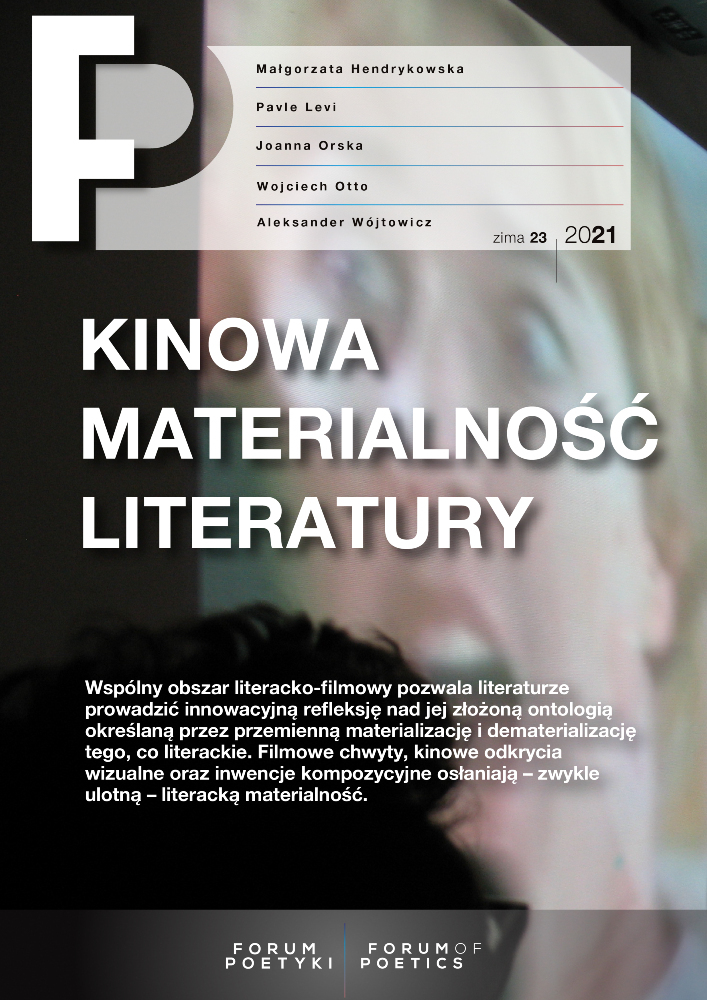Abstrakt
Artykuł jest próbą zdefiniowania zjawiska w światowym kinie współczesnym, które wykorzystując nowe sposoby komunikacji w obrębie sztuk wizualnych i ich haptyczności, stara się rekreować nastroje i wrażliwości konotowane z kulturą minionych czasów. Fortepian Jane Campion, jako świadectwo zaangażowanej lektury przede wszystkim poezji Emily Dickinson, ale też Wichrowych Wzgórz Emily Brontë, staje się tu przykładem fabuły z jednej strony nasyconej perspektywami, motywami i sytuacjami zaczerpniętymi z tych utworów, z drugiej wykorzystuje stylistyczną multisensoryczność kina, by w przedstawionych bohaterach i przedmiotach ich otaczających odtwarzać dynamikę relacji i nastroje znane z przekazów o kulturze połowy XIX wieku. Dzięki temu staje się auraptacją (adaptacją auratyczną; ang. auraptation – auratic adaptation), adaptacją aury wyczytanej spomiędzy literackich świadectw epoki, przeniesieniem w dzisiejsze czasy i właściwe im media niepowstałej w wieku XIX opowieści.
Bibliografia
Baecque, Antoine de. „Ekrany. Ciało w kinie”. W Historia ciała. Tom 3. Różne spojrzenia. Wiek XX. Zredagowane przez Jean-Jacques Courtine. Przetłumaczone przez Krystyna Belaid i Tomasz Stróżyński, 347–367. Gdańsk: słowo/obraz terytoria, 2014.
Benjamin, Walter. Twórca jako wytwórca. Eseje i rozprawy. Przetłumaczone przez Robert Reszke. Warszawa: KR, 2011.
Bologne, Jean Claude. Historia uwodzenia. Od Antyku do dziś. Przetłumaczone przez. Katarzyna Marczewska. Warszawa: Oficyna Naukowa, 2012.
Bruzzi, Stella. Undressing Cinema. Clothing and Identity in the Movies. London: Routledge, 1997
Dickinson, Emily. Wiersze wybrane. Przetłumaczone przez Stanisław Barańczak. Kraków: Znak, 2000.
Homans, Margaret. Women Writers and Poetic Identity. Dorothy Wordsworth, Emily Brontë and Emily Dickinson. New Jersey: Princeton University Press, 1980.
Jacobs, Carol. „Playing Jane Campion’s Piano: Politically”. MLN vol. 109, nr 5 (1994): 757–785.
Jane Campion Interviews. Zredagowane przez Virginia Wright Wexman, Jackson: University Press of Missisipi, 1999.
Luhmann, Niklas. „Semantyka miłości”. Przetłumaczone przez Jerzy Łoziński. W Amtropologia ciała. Wybór tekstów. Zredagowane przez Małgorzata Szpakowska, 242–247. Warszawa: Wydawnictwa Uniwersytetu Warszawskiego, 2008.
Łuczak, Dorota. Foto-oko. Wizja fotograficzna wokół okulocentryzmu w sztuce I połowy XX wieku. Kraków: Universitas, 2018.
Margolis, Harriet. „«A Strange Heritage»: From Colonization to Transformation?”. W Jane Campion’s „The Piano”. Zredagowane przez Harriet Margolis, 1–41. Cambridge: Cambridge University Press, 2000.
Marks, Laura U. The Skin of the Film. Intercultural Cinema, Embodiment, and the Senses, Durham: Duke University Press, 2000.
Puis, Reshela du. „Romanticizing Colonialism. Power and Pleasure in Jane Campion’s The Piano”, The Contemporary Pacific vol. 8, nr 1 (1996): 51–79.
Reeves, James. „Preface”. W Emily Dickinson. Selected Poems. Zredagowane przez James Reeves, vii–lii. London: Heinemann, 1959.
Riu, Carmen Pérez. „Two Gothic Feminist Texts: Emily Brontë’s Wuthering Heights and the film, The Piano, by Jane Campion”. Atlantis vol. XXII, nr 1 (2000): 163–173.
Roux, Jean-Paul. Kobieta w historii i micie. Przetłumaczone przez Barbara Szczepańska, Warszawa: Volumen, 2010.
Różanowski, Ryszard. Pasaże Waltera Benjamina. Studium myśli. Wrocław: Wydawnictwo Uniwersytetu Wrocławskiego, 1997.
Sanders, Julie. Adaptation and appropriation. Abington–New York: Routledge, 2006.
Stocks, Kenneth. Emily Dickinson and the Modern Consciousness. Houndmills: Macmillan, 1988.
Wagner-Martin, Linda. Emily Dickinson. A Literary Life. London: Palgrave Macmillan, 2013.
Zerner, Henri. „Spojrzenie artystów”. W Historia ciała. T. 2. Od rewolucji do I wojny światowej. Zredagowane przez Alain Corbin. Przetłumaczone przez Krystyna Belaid i Tomasz Stróżyński, 79–108. Gdańsk: słowo/obraz terytoria, 2013
Licencja
Za prawa cytowania fragmentów innych publikacji (tekstów, tabel, rycin oraz ilustracji) odpowiedzialni są autorzy artykułu.

